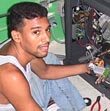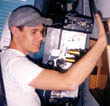|
|
This topic comprises 2 pages: 1 2
|
|
Author
|
Topic: Diodes on Kneisley Rectifiers
|
|
|
|
|
|
|
|
|
|
|
Paul G. Thompson
The Weenie Man

Posts: 4718
From: Mount Vernon WA USA
Registered: Nov 2000
|
 posted 04-24-2003 01:21 AM
posted 04-24-2003 01:21 AM




Why are the bulbs failing at 400 hours? I would look at those areas first, primarly ventilation of the lamphouse.
People disagree with me on this, but if one diode goes, replace them all. As far as testing them is concerned, the most accurate way that I know of is testing them under load with volt meters ammeters, and temperature bulbs. Current meters to monitor the current flow through it, volt meters to check the voltage drop across the doide, and a temperature bulb to see how hot the damn thing is getting.
High quality meters will give a very good idea but when these diodes are actually in the circuit working under load, things change. It is cheaper in the long run to just replace the whole complement of diodes.
In addition, old diodes have been known to fail because of thermal stress over years of operation, and will fail without warning. It always amazes me when some people use a Zillion-Watt Solder Gun to solder a 12 gauge wire to a little stud rectifier without even thinking of using a heat sink to route the heat away from the diode's internal junction. Then they cannot figure out why that diode failed in about a month or so.
I tell them they are stupid. The reason why it failed is because it was severely heat damaged when it was installed. And then, they didn't even use new compound when the diode was bolted in and over-torqued, no less....
I once saw a huge shipboard 2-story Fairbanks Morris Diesel Engine in the old Olympic. Each main bearing had a temperature gauge to measure the temperature of the actual bearing. As I looked around, each main bearing had a different temperature, sometimes drastic enough to raise the eyebrow of the Chief Engineer.
Get the point?
ARG!!!!! Hammer Technicians..... ![[fu]](graemlins/fu.gif) ![[thumbsdown]](graemlins/thumbsdown.gif) ![[sex]](graemlins/sex.gif) ![[bs]](graemlins/bs.gif) ![[puke]](graemlins/puke.gif)
| IP: Logged
|
|
|
|
|
|
|
|
|
|
Paul G. Thompson
The Weenie Man

Posts: 4718
From: Mount Vernon WA USA
Registered: Nov 2000
|
 posted 04-24-2003 01:48 PM
posted 04-24-2003 01:48 PM




Elvis, I have seen those values "all over the place". But remember, that is a test that uses practically nothing for current and voltage. About the only good that test is is to determine if the diode is open or shorted. in most cases, that's all you need to know. I have not had too much problems if they read somewhere about .375 to .650. Take a bunch of new ones and try them, and plant those figures in your mind. I'll almost bet you will find that each one (even the new ones) will have a different reading.
I respectfully disagree with of Gordon's first paragraph when he said it was usually not necessary to change them all. I agree with the rest of his comments, and fully agree with him on his second paragraph.
As far as diode lead wire size is concerned, it depends on the power supply. I will agree that a 12 gauge wire is not heavy enough to be using in some larger high current power supplies, but it will probably work just fine in the lower ones such as a 1,000 or 1,600 watt unit. Rarely did I ever see anything smaller than 10 gauge wire anything above 1600 watts. Also, the type of wire used makes all the difference in the world. I would opt for bonding strap style I have seen in some good quality power supplies instead of AWG 12, 10, or what-have-you.
Diodes with pigtails already attached can be purchased, and I will go out of my way to get those styles. The price difference between the two is not that big of a deal.
I never liked the idea of using soldering equipment on diodes. No matter how good of a heat sink you use, damaging heat can still reach the PN junction inside the doide.
At one time, I did just change one diode instead of the whole complement. That was cool, because I knew I would be back in about 2 to 3 months to change another.
Good job security.... but non-professional in my books. It is an injustice to that person trying to make an honest "buck" so he or she can feed themselves and their family.
I discontinued that "change one diode" practice when I left a theatre supply company I used to work for years ago.
| IP: Logged
|
|
|
|
|
|
|
|
|
|
|
|
All times are Central (GMT -6:00)
|
This topic comprises 2 pages: 1 2
|
Powered by Infopop Corporation
UBB.classicTM
6.3.1.2
The Film-Tech Forums are designed for various members related to the cinema industry to express their opinions, viewpoints and testimonials on various products, services and events based upon speculation, personal knowledge and factual information through use, therefore all views represented here allow no liability upon the publishers of this web site and the owners of said views assume no liability for any ill will resulting from these postings. The posts made here are for educational as well as entertainment purposes and as such anyone viewing this portion of the website must accept these views as statements of the author of that opinion
and agrees to release the authors from any and all liability.
|

 Home
Home
 Products
Products
 Store
Store
 Forum
Forum
 Warehouse
Warehouse
 Contact Us
Contact Us




 Printer-friendly view of this topic
Printer-friendly view of this topic





![[thumbsup]](graemlins/thumbsup.gif)



![[fu]](graemlins/fu.gif)
![[thumbsdown]](graemlins/thumbsdown.gif)
![[sex]](graemlins/sex.gif)
![[bs]](graemlins/bs.gif)
![[puke]](graemlins/puke.gif)
![[Confused]](confused.gif)



